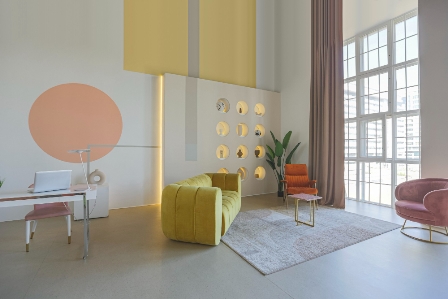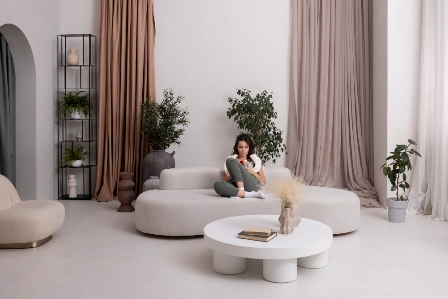In a world often characterized by excess and abundance, the concept of minimalist interior design has emerged as a refreshing and widely embraced approach to home decor. In this article, we will explore the principles, benefits, and practical aspects of mastering the art of minimalist interior design.
Principles of Minimalist Design
Minimalism is not merely about having fewer things but rather a deliberate choice to focus on what truly matters. The core principles include simplicity, functionality, and the strategic use of negative space. Embracing these principles lays the foundation for a visually appealing and purposeful interior.
Benefits of Minimalist Interior Design
Minimalist interior design isn’t just a visual aesthetic; it’s a lifestyle choice that brings about various benefits to both the inhabitants and the space itself. Let’s explore the positive impacts of adopting a minimalist approach to interior design.
Psychological Well-being
Minimalist spaces are known for their calming and soothing effects on the mind. The intentional use of clean lines, neutral colors, and open spaces contributes to a sense of tranquility. Reduced visual clutter helps in creating a peaceful environment, promoting mental clarity and reducing stress levels.
Enhanced Focus and Productivity
A clutter-free space translates to a clutter-free mind. In minimalist interiors, distractions are minimized, allowing individuals to focus better on tasks at hand. This enhanced concentration can lead to increased productivity, making minimalist design an excellent choice for home offices or study areas.
Easier Maintenance
One of the practical advantages of minimalist interior design is the ease of maintenance. With fewer items to clean, organize, and dust, the upkeep of the living space becomes more manageable. This benefit is especially valuable for individuals with busy lifestyles who seek a home that is both stylish and low-maintenance.
Improved Quality of Life
By intentionally choosing and keeping only what is essential, minimalist design encourages a shift in perspective towards a more intentional and meaningful life. This mindful approach to living can result in a greater appreciation for the things that truly matter, fostering an improved overall quality of life.
Increased Energy Efficiency
Minimalist interiors often make use of natural light, emphasizing the importance of open spaces and large windows. This design choice not only contributes to the aesthetics but also promotes energy efficiency by reducing the reliance on artificial lighting during the day.
Elements of Minimalist Design
At the heart of minimalist design are specific elements that distinguish it from other styles. A neutral color palette, clean lines, and limited decorative elements are crucial components. These elements work together to create a sense of calm and order within a space.
Furniture Selection
Choosing the right furniture is pivotal in achieving a minimalist interior. Opting for functional and essential pieces, incorporating multi-functional furniture, and prioritizing quality over quantity are key considerations. This section will guide readers in making mindful choices that align with minimalist principles.
Lighting in Minimalist Spaces
Lighting plays a crucial role in minimalist design, with an emphasis on integrating natural light and incorporating simple, sleek fixtures. This section will delve into the nuances of lighting design within minimalist spaces, enhancing the overall ambiance.
Organizational Strategies
Minimalism thrives on decluttered spaces. Practical tips for decluttering and effective storage solutions will be discussed in this section, providing readers with actionable steps to maintain a minimalist environment.
Minimalist Decor
Decorating in a minimalist space requires a thoughtful approach. From purposeful decorations to the strategic placement of plants and minimalist art, this section will guide readers on how to add aesthetic elements without compromising the core principles of minimalism.
Achieving Minimalism on a Budget
Contrary to popular belief, minimalist design can be achieved on a budget. This section will explore various DIY projects and offer smart shopping tips to help readers create a minimalist haven without breaking the bank.
Balancing Minimalism with Personal Style
While minimalism has its principles, it’s essential to balance them with personal style. This section will guide readers on how to infuse their personality into minimalist spaces, creating a harmonious blend of simplicity and individuality.
Common Mistakes to Avoid
Even the most well-intentioned endeavors can go astray. This section will highlight common mistakes people make in pursuing minimalist design, such as overcomplicating simplicity, succumbing to clutter, and neglecting functionality.
Minimalism in Different Rooms
Applying minimalist principles to various rooms in the house requires a nuanced approach. This section will provide specific guidance on achieving minimalism in the bedroom, living room, kitchen, and other spaces.
Trend Forecast in Minimalist Design
As design trends evolve, so does minimalist design. This section will explore emerging trends and the growing emphasis on sustainability within the minimalist movement, keeping readers informed about the latest developments.
FAQs
Yes, minimalism can be adapted to suit various home sizes and styles.
Customization through personal items and thoughtful decor choices is key.
Neutral colors like white, beige, and gray are commonly recommended for minimalist interiors.
Absolutely, with strategic planning, DIY projects, and smart shopping, minimalism can be affordable.
Minimalism transcends trends; it’s a lifestyle choice with enduring value in promoting simplicity and well-being.
Conclusion
Mastering the art of minimalist interior design is not just about creating visually pleasing spaces but also about fostering a lifestyle that values simplicity and purpose. By embracing the principles and incorporating the practical tips provided in this article, readers can embark on a journey to transform their living spaces into minimalist havens.





